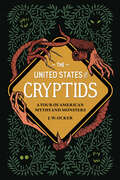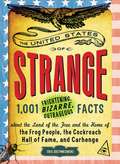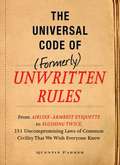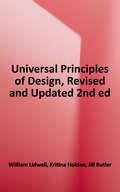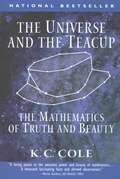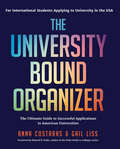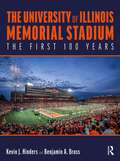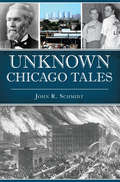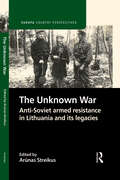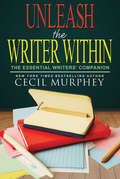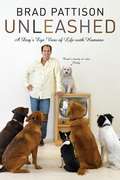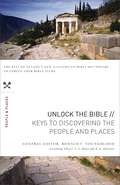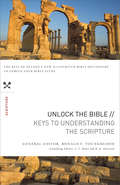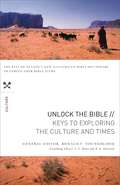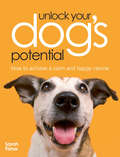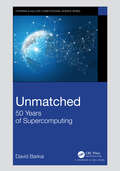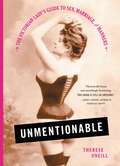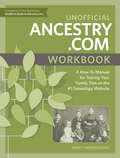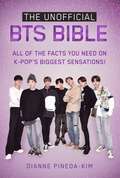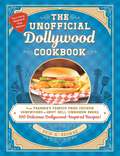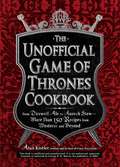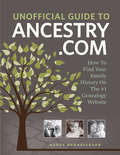- Table View
- List View
The United States of Cryptids: A Tour of American Myths and Monsters
by J. W. OckerMeet the monsters in our midst, from bigfoot to Mothman and beyond!Welcome to the United States of Cryptids, where mysterious monsters lurk in the dark forests, deep lakes, and sticky swamps of all fifty states. From the infamous Jersey Devil to the obscure Snallygaster, travel writer and chronicler of the strange J. W. Ocker uncovers the bizarre stories of these creatures and investigates the ways in which communities embrace and celebrate their local cryptids. Readers will learn about: • Batsquatch of Washington, a winged bigfoot that is said to have emerged from the eruption of Mount Saint Helens• Nain Rouge of Michigan, a fierce red goblin that has been spotted before every major city disaster in Detroit• Flatwoods Monster of West Virginia, a robotic extraterrestrial that crash-landed in rural Appalachia• Lizard Man of South Carolina, a reptilian mutant that attacked a teenager in the summer of 1988• Glocester Ghoul of Rhode Island, a fire-breathing dragon that guards a hoard of pirate treasure• And many more! Whether you believe in bigfoot or not, this fully illustrated compendium is a fun, frightening, fascinating tour through American folklore and history, exploring the stories we tell about monsters and what those stories say about us.
The United States of Strange
by Eric GrzymkowskiLife, Liberty, and the Pursuit of All Things Weird Sure, you probably know that George Washington was our first president and that Christopher Columbus accidentally discovered America in 1492, but did you know that there are more plastic flamingos in the United States than there are real ones and that Disneyland employees were not permitted to wear their own underwear while dressing in character until 2001? Behind the portrait of America that history classes, news reports, and boring documentaries have painted lies a strange and perplexing country that you couldn't imagine even in your wildest dreams. Featuring 1,001 shocking facts, this book reveals all the secrets and weirdness that you never knew about the United States. From the thirty-two(!) bathrooms in the White House to the fact that a single U.S.-made hamburger may contain meat from 100 different cows, these wacky tidbits will guarantee that you'll never look at this nation the same way again!
The United States of Strange: 1,001 Frightening, Bizarre, Outrageous Facts About the Land of the Free and the Home of the Frog People, the Cockroach Hall of Fame, and Carhenge
by Eric GrzymkowskiLife, Liberty, and the Pursuit of All Things WeirdSure, you probably know that George Washington was our first president and that Christopher Columbus accidentally discovered America in 1492, but did you know that there are more plastic flamingos in the United States than there are real ones and that Disneyland employees were not permitted to wear their own underwear while dressing in character until 2001?Behind the portrait of America that history classes, news reports, and boring documentaries have painted lies a strange and perplexing country that you couldn't imagine even in your wildest dreams. Featuring 1,001 shocking facts, this book reveals all the secrets and weirdness that you never knew about the United States. From the thirty-two(!) bathrooms in the White House to the fact that a single U.S.–made hamburger may contain meat from 100 different cows, these wacky tidbits will guarantee that you'll never look at this nation the same way again!
The United States of Strange
by Eric GrzymkowskiLife, Liberty, and the Pursuit of All Things Weird Sure, you probably know that George Washington was our first president and that Christopher Columbus accidentally discovered America in 1492, but did you know that there are more plastic flamingos in the United States than there are real ones and that Disneyland employees were not permitted to wear their own underwear while dressing in character until 2001? Behind the portrait of America that history classes, news reports, and boring documentaries have painted lies a strange and perplexing country that you couldn't imagine even in your wildest dreams. Featuring 1,001 shocking facts, this book reveals all the secrets and weirdness that you never knew about the United States. From the thirty-two(!) bathrooms in the White House to the fact that a single U. S. 'made hamburger may contain meat from 100 different cows, these wacky tidbits will guarantee that you'll never look at this nation the same way again!
Universal Principles of Design: 125 Ways to Enhance Usability, Influence Perception, Increase Appeal, Make Better Design Decisions, and Teach Through Design
by William Lidwell Kritina Holden Jill ButlerUniversal Principles of Design, Revised and Updated is a comprehensive, cross-disciplinary encyclopedia covering 125 laws, guidelines, human biases, and general considerations important to successful design. Richly illustrated and easy to navigate, it pairs clear explanations of every design concept with visual examples of the ideas applied in practice. From the 80/20 Rule to the Weakest Link, every major design concept is defined and illustrated. <p><p> Whether a marketing campaign or a museum exhibit, a video game or a complex control system, the design we see is the culmination of many concepts and practices brought together from a variety of disciplines. Because no one can be an expert on everything, designers have always had to scramble to find the information and know-how required to make a design work—until now. <p><p> Just a few of the principles that will broaden your design knowledge, promote brainstorming, and help you check the quality of your work: <p> Baby-Face Bias <p>Expectation Effect <p>Golden Ration <p>Ockham's Razor <p>Proximity <p>Scaling Fallacy <p><p>The book is organized alphabetically so that principles can be easily and quickly referenced by name. For those interested in addressing a specific problem of design, the principles have also been indexed by questions commonly confronting designers (How can I help people learn from my design? How can I enhance the usability of a design? How can I make better design decisions? ...). <p><p> Each principle is presented in a two-page format. The left-hand page contains a succinct definition, a full description of the principle, examples of its use, and guidelines for use. Side notes appear to the right of the text, and provide elaborations and references. The right-hand page contains visual examples and related graphics to support a deeper understanding of the principle. <p><p> This landmark reference is the standard for designers, engineers, architects, and students who seek to broaden and improve their design expertise.
The Universe And The Teacup: The Mathematics of Truth and Beauty
by K. C. ColeFilled with “a thousand fascinating facts and shrewd observations (Martin Gardner, Los Angeles Times), this “beguiling and lucid book” (San Francisco Chronicle) demonstrates how the truth and beauty of everything, from relativity to rainbows, is all in the numbers. Line drawings.
The University Bound Organizer: The Ultimate Guide to Successful Applications to American Universities
by Anna Costaras Gail LissFor international students: the only book you’ll ever need to guide you through the US college and university admissions process.University admissions in the United States is tougher than ever. Nearly three million students are expected to enroll as first-time freshmen in colleges and universities in the United States this school year. How can you prepare, get organized, and stay focused throughout the search and admission process?Applying to university can be intimidating and overwhelming for both teens and parents. The process is a maze of standardized tests, school research, university fairs, applications, interviews, CVs, essays, and deadlines. This university planner will guide you easily through each stage and includes tips to help you submit your best application.The University Bound Organizer helps students:Understand what US admission officers are looking for in an applicantPrevent common mistakes students make on their applicationsBuild a personal profilePlan an individualized testing scheduleResearch universities to identify schools that are a good fitDevelop a balanced list of schoolsSecure letters of recommendationComplete and submit applications accurately and on timeDevelop their university application essayApply for financial aid and scholarshipsAce interviewsSort and manage application resultsMake a final decision
The University of Illinois Memorial Stadium: The First 100 Years
by Kevin Hinders Benjamin BrossThis book offers a rigorous but graphically compelling narrative historic analysis of one of the most important civic buildings not only of the University of Illinois Urbana-Champaign, or the State of Illinois, but arguably of the United States, Memorial Stadium.Like all spatial products, the design and construction of the University of Illinois Memorial Stadium embodies the social, political, economic, aspiration, and aesthetic values of its time. This book will engage in critical analysis including documenting the civic discourse that led to the Stadium and thereafter explore the iterative nature of the Stadium in shaping civic discourse. In this vein, central topics include its role in embodying the state’s economic growth; the changing nature of the sociocultural tendencies and its impact on campus life and the University’s community; the Stadium’s effects on UIUC sports and the campus’ built environment; the rise of College sports as big business; and the impact on mass culture across the State and the country, like the use of stadiums as concert venues and place of public discourse. More than a simple study of the building’s conceptualization, design, and construction, this book reveals why Illinois’ Memorial Stadium is an iconic part of the American Midwest’s built landscape and in many ways part of the American mythic landscape.This will be interesting reading for all those familiar with the building, as well as all students and scholars of sports architecture.
Unknown Chicago Tales
by John R. SchmidtChicago's most famous stories tend to crowd out the competition and shout down alternate perspectives. Visit with the man who founded a 150-year-long Chicago political dynasty. Take a peek at some of the lesser-known Chicago film classics. Review Professor Moriarty's Chicago caper and Annie Oakley's cocaine case. Uncover the lengths to which Chicago's long-celebrated Mr. Pioneer Settler went to keep a slave. Discover why the Kennedy curves at Division Street and why the county jail saved a gallows for fifty years. From Death Valley Scotty's wild ride to the bowling ball that went around the world, John Schmidt provides a parade of Chicago originals.
The Unknown War: Anti-Soviet armed resistance in Lithuania and its legacies (Europa Country Perspectives)
by Arūnas StreikusThe armed anti-Soviet resistance movement which arose in the second half of 1944 in Lithuania, as Soviet forces began to reoccupy the Baltic countries and Galicia, sparking a nearly decade-long fierce military conflict, has yet to become established in the common narrative of contemporary European history. However, controversy regarding the nature of this `war after the war' and its legacies constitutes one of the core elements in the contemporary information warfare waged by Russia against its neighbouring countries. The origins of various distortions surrounding the story of the partisan war in the western borderlands of the Soviet Union can even be traced to the final stages of that war, when Soviet propaganda sought to discredit the campaign as a battle waged by criminal elements. In this example of a historical event charged with controversial memories and geopolitical connotations, a thorough academic approach is extraordinarily instrumental. Responding to the growing need for historical research capable of providing international readers with the latest findings in the thematic field under question, six scholars from Vilnius University address the diverse aspects of this phenomenon as well as its role in the culture and politics of memory. Toward this end, this analysis – among the most comprehensive explorations of this history to date – is being released in both Lithuanian and English.
Unleash the Writer Within: The Essential Writers’ Companion
by Cecil MurpheyBeloved author Cecil (Cec) Murphey says, "The best kind of writing occurs when it comes from the heart. It's called being authentic or transparent. Too many writers have an insatiable need to be accepted, liked, or admired, and those needs become more important than being true to their convictions. Be you when you write."But having the courage to tap into your innermost self and write purely from your spirit doesn't always come naturally, which is why he wrote Unleash the Writer Within to guide you along the way. In this book, Cec helps you:* Answer why you write;* Find the real you;* Understand your inner critic;* Determine your strengths and weaknesses;* Honor, embrace, and grow your voice;* Discover your rhythm;* Overcome your barriers to honest writing.Unleash the Writer Within is sure to become your most-used and marked-up writing companion. It also serves as an excellent resource for writers' events, group discussions, and conferences.Note: UNLEASH THE WRITER WITHIN is a previously published work, and is not substantially different from the original edition.
Unleashed: Dog's Eye View of Life With Humans
by Brad PattisonDog advocate and human-being life coach Brad Pattison brings his innovative, tough-love training and in-your-face counselling skills to the page. Whether you're just getting started on training your new pup, looking to take your good relationship with your dog to a higher level, or trying to correct negative dog behaviours, Brad Pattison's book will provide DIY training material that underlines how you can teach your dog to be a healthy, happy member of your family. Each chapter focuses on a different aspect of Pattison's established training techniques, anchored by real-life success stories and focus dogs. Examples of chapter titles: Dog Speak: Harnessing Canine Communication Methods to Enhance Interspecies Relations; Coddled Canines: The Dangers of Heavy Petting and the Best Methods for Rewarding Your Dog; and Co-Evolution: Raising the Bar and Strengthening the Bond. From the Hardcover edition.
Unlock the Bible: Keys to Discovering the People & Places
by F. F. Bruce Ronald Youngblood R. K. HarrisonBuild your Bible study library with this essential book on the people and places of the Bible. Unlock the Bible: Keys to Discovering the People & Places includes the best articles on the most important people and places in Scripture. Each article is drawn from Nelson's New Illustrated Bible Dictionary. Under the direction of Ronald F. Youngblood, the world's leading evangelical scholars updated and revised classic articles drawn from Herbert Lockyer, F. F. Bruce, and R. K. Harrison's extensive Bible dictionary. Features include: Alphabetical listing of topics Works with any major translation Pronunciation guide
Unlock the Bible: Keys to Understanding the Scripture
by Ronald F. YoungbloodEnrich your Bible study with one convenient book. Unlock the Bible: Keys to Understanding the Scripture includes the best articles on reading the books of the Bible, drawn from Nelson's New Illustrated Bible Dictionary. Under the direction of Ronald F. Youngblood, the world's leading evangelical scholars updated and revised classic articles drawn from Herbert Lockyer, F. F. Bruce, and R. K. Harrison's extensive Bible dictionary. Outlines, maps, pictures, and charts make the Bible's contents clearer for pastors, teachers, students, and devotional readers. Features include: The most useful information at your fingertips Works with any major translation Outlines, maps, and charts
Unlock the Bible: Keys to Exploring the Culture & Times
by Ronald F. YoungbloodBuild your Bible study library with this essential book on the cultures and history of the biblical world. Each article comes from Nelson's New Illustrated Bible Dictionary. This volume of the Unlock the Bible series includes articles on the most important kingdoms, peoples, and events in Scripture. Under the direction of Ronald F. Youngblood, the world's leading evangelical scholars updated and revised classic articles drawn from Herbert Lockyer, F. F. Bruce, and R. K. Harrison's extensive Bible dictionary. Features include: The most useful information at your fingertips Single-column format Maps and charts
Unlock Your Dog's Potential: How to Achieve a Calm and Happy Canine
by Sarah FisherThe renowned animal trainer shares her unique behavior management techniques to get your dog happier, healthier, less stressed, and more obedient. Animal trainer Sarah Fisher is known for transforming the behavior of dogs who are beyond ordinary rehabilitation techniques. She also helps dog owners go beyond passive dog ownership to become observant, understanding, and pro-active dog guardians. In Unlock Your Dog&’s Potential, Fisher offers step-by step instructions to using her methods at home. With simple exercises and invaluable training advice, you can safely and effectively reduce unwanted behaviors such as leash pulling, barking, and chewing, You will also learn to recognize symptoms of stress or concern in your dog, and how you can alleviate these tensions to improve your dog&’s well-being and strengthen your bond.Unlock Your Dog&’s Potential covers a wide range of unique dog management techniques, including handling and bodywork exercises to improve movement and trainability. Case studies of dogs Fisher has worked with appear throughout the book to show how her techniques relate to real-life situations.
Unmatched: 50 Years of Supercomputing (Chapman & Hall/CRC Computational Science)
by David BarkaiUnmatched: 50 Years of Supercomputing: A Personal Journey Accompanying the Evolution of a Powerful ToolThe rapid and extraordinary progress of supercomputing over the past half-century is a powerful demonstration of our relentless drive to understand and shape the world around us. In this book, David Barkai offers a unique and compelling account of this remarkable technological journey, drawing from his own rich experiences working at the forefront of high-performance computing (HPC).This book is a journey delineated as five decade-long ‘epochs’ defined by the systems’ architectural themes: vector processors, multi-processors, microprocessors, clusters, and accelerators and cloud computing. The final part examines key issues of HPC and discusses where it might be headed.A central goal of this book is to show how computing power has been applied, and, more importantly, how it has impacted and benefitted society. To this end, the use of HPC is illustrated in a range of industries and applications, from weather and climate modeling to engineering and life sciences. As such, this book appeals to both students and general readers with an interest in HPC, as well as industry professionals looking to revolutionize their practice.From the Foreword:“David Barkai's career has spanned five decades, during which he has had the rare opportunity to be part of some of the most significant developments in the field of supercomputing. His personal and professional insights, combined with his deep knowledge and passion for the subject matter, make this book an invaluable resource for anyone interested in the evolution of HPC and its impact on our lives.”-Horst Simon, Director, Abu Dhabi Investment Authority (ADIA) Lab
Unmentionable: The Victorian Lady's Guide To Sex, Marriage, And Manners
by Therese OneillHave you ever wished you could live in an earlier, more romantic era? Ladies, welcome to the 19th century, where there's arsenic in your face cream, a pot of cold pee sits under your bed, and all of your underwear is crotchless. (Why? Shush, dear. A lady doesn't question.) UNMENTIONABLE is your hilarious, illustrated, scandalously honest (yet never crass) guide to the secrets of Victorian womanhood, giving you detailed advice on: ~ What to wear ~ Where to relieve yourself ~ How to conceal your loathsome addiction to menstruating ~ What to expect on your wedding night ~ How to be the perfect Victorian wife ~ Why masturbating will kill you ~ And moreIrresistibly charming, laugh-out-loud funny, and featuring nearly 200 images from Victorian publications, UNMENTIONABLE will inspire a whole new level of respect for Elizabeth Bennett, Scarlet O'Hara, Jane Eyre, and all of our great, great grandmothers. (And it just might leave you feeling ecstatically grateful to live in an age of pants, super absorbency tampons, epidurals, anti-depressants, and not-dying-of-the-syphilis-your-husband-brought-home.)
Unnatural Quotations: A compendium of quotations by, for or about gay people
by Leigh W. RutledgeLeigh Rutledge, author of The Gay Book of Lists, has been back digging through his files. The result is Unnatural Quotations, an entertaining collection of quotes by or about gay people. Hundreds of familiar figures--both past and present, homophilic and homophobic--are represented here. Some people quoted include: Bette Davis, Gore Vidal, Bella Abzug, George H. W. Bush, Tennessee Williams, Woody Allen, Dolly Parton, Frank Zappa, Michelangelo, Tallulah Bankhead, Joan Baez, Billie Jean King, Rod McKuen, Christopher Isherwood, Boy George, Frederick the Great, Margaret Mead, Jimmy Carter, Truman Capote, Ned Rorem, Arnold Schwarzenegger, Marlon Brando, Ronald Reagan, Ed Koch, Jerry Brown, Imelda Marcos, John Lennon and many, many more! Well-illustrated and indexed, Unnatural Quotations is a book you will come back to and enjoy again and again.
Unofficial Ancestry.com Workbook: A How-To Manual for Tracing Your Family Tree on the #1 Genealogy Website
by Nancy HendricksonA How-To Manual for Tracing Your Family Tree on the #1 Genealogy Website
The Unofficial BTS Bible: All of the Facts You Need on K-Pop's Biggest Sensations!
by Dianne Pineda-KimJoin BTS&’s ARMY and learn the history of the international K-POP sensation! BTS (aka Bangtan Sonyeondan) has become one of K-POP&’s most well-known singing groups. The seven-member Korean boy band formed in 2013 and has slowly grown to worldwide fame through their music. Despite slow beginnings, the K-POP group now has millions of listeners around the world. They led the Korean Wave of music into the United States in 2017, and as of 2019, they are the only Korean group to top the US Billboard 200, and the first group since the Beatles to have three number-one albums in less than a year. BTS is also known for breaking the mold of K-POP, including social topics such as mental health, individualism, and social commentary in their hip-hop lyrics. TIME Magazine named the Korean Pop group as one of the 25 most influential people on the internet and named them as one of TIME's 100 most influential people of 2019. In the BTS Bible, you&’ll learn everything you could want to know about the sensational singing group, including: Individual member profilesBand concept and styleHistory of their six-year rise to fameChart-topping songs and videosInterviews with worldwide fans and music expertsAnd more! Don&’t get left behind in the wake of the BTS success. Read all about the K-POP group that is changing the face of international music in the Unofficial BTS Bible.
The Unofficial Dollywood Cookbook: From Frannie's Famous Fried Chicken Sandwiches to Grist Mill Cinnamon Bread, 100 Delicious Dollywood-Inspired Recipes! (Unofficial Cookbook)
by Erin BrowneBring the fun of Dollywood right to your own kitchen with 100 of the most delicious foods from Dollywood and its surrounding parks.From favorite snacks and main dishes to refreshing drinks and popular desserts, Dollywood has some incredible food. And now, you can recreate all of your favorites—and discover some new favorites—with these 100 recipes in The Unofficial Dollywood Cookbook. You&’ll learn to make: -Frannie&’s Famous Fried Chicken Sandwich from Grandstand Café -Meatloaf Stackers from Granny Ogle&’s Ham &‘n&’ Beans -Fruity Pebbles Funnel Cakes from Crossroads Funnel Cakes -And much more! Perfect for everyone from Dollywood super fans who miss those familiar flavors in between trips to fans who have never visited but still want to experience the amazing food, The Unofficial Dollywood Cookbook has all the recipes you&’ll need to make treats worthy of Dolly Parton herself.
The Unofficial Game of Thrones Cookbook: From Direwolf Ale to Auroch Stew - More Than 150 Recipes from Westeros and Beyond (Unofficial Cookbook)
by Alan KistlerAn Epic Culinary Journey to the Heart of Westeros!Eat like a Lannister. Brew spirits to warm you in the coming winter. Treat guests to exotic sweets and alchemy-inspired cocktails. With this collection of hearty meals inspired by George R. R. Martin's A Song of Ice and Fire series, it's all possible! Every dish finds its roots in the pages that brought Westeros to life, including:Arbor Red Wine-the finest spirit in the Seven KingdomsThe House of Stark's Venison, Apple, Cheddar Plaits-savory meat pies, fit for any Warden of the NorthThe Imp's Wild Strawberry Fool-a dessert light enough to make Tyrion smileWilding Grilled Pork Chops with Stir-Grilled Apples-the meal of choice at Craster's KeepTears of Lys-the concoction of choice for bartenders and assassins alike Feast your imagination on entrees, desserts, snacks, and drinks that will make your fantasies a reality!
Unofficial Guide to Ancestry.com: How to Find Your Family History on the No. 1 Genealogy Website
by Nancy HendricksonMaster the world's #1 genealogy website! Discover the secrets to Ancestry.com success! This book will help you get the most out of your Ancestry.com subscription by showing you how to take advantage of all the world's biggest genealogy website has to offer--and how to find answers to your family tree questions within its 14 billion records, 60 million family tree and 32,000 databases. What you'll learn: Step-by-step strategies for structuring your searches to find what you're looking for faster How to drill down to specific records, time periods and topics using the card catalog Details on each of Ancestry.com's historical record collections, including what you can expect to find in them--and when you need to look elsewhere Tips for creating and managing your family tree on Ancestry.com, as well as connecting your tree to others on the site Timesaving tricks to maximize your Ancestry.com Hints (the "shaky leaf"), Tree Sync with Family Tree Maker, and the Ancestry.com mobile app Each chapter includes step-by-step examples with illustrations to show you exactly how to apply the techniques to your genealogy. Whether you've just begun dabbling in family history or you're a longtime Ancestry.com subscriber, this book will turn you into an Ancestry.com power user!
